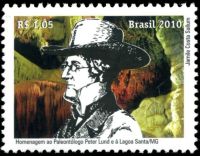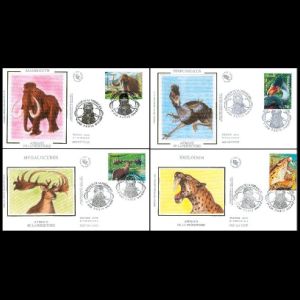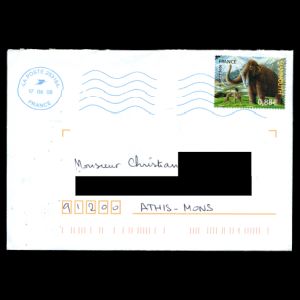France 2008 "Prehistoric animals"
| <prev | back to index | next> |
| Issue Date | 21.04.2008 |
| ID | Michel: 4402-4405, Bl. 86 ; Scott: 3430-3433 , 3433a Stanley Gibbons: 4383-4386 , MS4387 Yvert et Tellier: 4175-4178 , BF119, Category: pR |
| Design | Christian Broutin |
| Stamps in set | 4 |
| Value |
0.55€ - Phorusrhacos (misspelled Phorusrhacos) 0.55€ - Smilodon 0.65€ - Megaloceros 0.88€ - Mammoth (Mammuthus primigenius) and Neandertal hunters |
| Emission/Type | commemorative |
| Issue place | Paris, Rinxent, Montbeliard, Tarascon sur Ariege |
| Size (width x height) | 40,85 x 30 mm / 30 x 40,85 ; Mini-Sheet: 110 mm x 160 mm |
| Layout | Sheet of 40 stamps, Mini-Sheet with 4 stamps |
| Products | FDC x4 |
| Paper | no Watermark, without phosphor strip |
| Perforation | 13 x 13 |
| Print Technique | Rotogravure, Multicolor |
| Printed by | Phil@Poste Boulazac |
| Quantity | |
| Issuing Authority | La Poste |

On April 21st, 2008, the Post Authority of France issued a set of 4 stamps "Prehistoric animals", printed as Mini-Sheets of the set of 4 and sheets of each individual stamp. Sheets contain 40 stamps.
The set depicts four prehistorical animals who lived at different times in different part of the world and could not have lived together as these animals lived at different times and in different parts of the world, are depicted on the Mini-Sheet, as well as some Neanderthals hunters. The animals are: Megaloceros - great deer - "Irish elk", Mammoth (Mammuthus primigenius) and Neandertal hunters, Phorusrhacos (misspelled Phorusrhacos), Smilodon.
Megaloceros - great deer - "Irish elk"
 |
| Great deer Megaloceros on stamp of France 2008, MiNr.: 4177, Scott: 3432. |
The Irish elk evolved during the glacial periods of the last million years, during the Pleistocene Epoch.
It ranged throughout Europe, northern Asia and northern Africa, and a related form is known from China.
The name "Irish" has stuck because excellent, well-preserved fossils of the giant deer are especially common in lake sediments and peat bogs in Ireland. On the other hand, the complete skeleton, on display at the Paleontological Institute in Moscow, was found at the other end of Europe, near the Russian town of Sapozhek.
Megaloceros savini first found near Sainte Savine, France. Its antlers were straight, with thorn-like prongs. The lowermost prongs near the base were palmate.
A Mammoth is any species of the extinct genus Mammuthus.
 |
| Mammoth (Mammuthus primigenius) and Neandertal hunters on stamp of France 2008, MiNr.: 4178, Scott: 3433. |
They were often equipped with long curved tusks and, in northern species, a covering of long hair. They lived from the Pliocene Epoch from around 4.8 million years ago, into the Holocene about 4,500 years ago.
The word mammoth comes from the Russian mamont, probably in turn from the Vogul (Mansi) language, mang ont, meaning "earth horn". Like their modern relative, the elephant (Asian or African), mammoths were quite large.
The largest known species, Songhua River mammoth (Mammuthus sungari), reached heights of at least 5 meters at the shoulder. Mammoths would probably normally weigh in the region of 6 to 8 tons, but exceptionally large males may have exceeded 12 tons.
However, most species of mammoth were only about as large as a modern Asian Elephant. Fossils of species of dwarf mammoth have been found on the Californian Channel Islands (Mammuthus exilis) and the Mediterranean island of Sardinia (Mammuthus lamarmorae). There was also a race of dwarf woolly mammoths on Wrangel Island, north of Siberia, within the Arctic Circle.
Phorusrhacos (Terror Bird)
 |
| Phorusrhacos on stamp of France 2008, MiNr.: 4176, Scott: 3430. |
 |
| Florentino Ameghino on stamp Argentina 1956, MiNr.: 649, Scott: 658. |
The terror birds lived in woodlands and grasslands. Among the bones found in the stratum of the Santa Cruz Formation (now considered as mainly of mid-Miocene age) was the piece of a mandible which Florentino Ameghino (1887) at first described as that of an edentate mammal.
In 1891, it was recognized to be a bird. Remains are known from several localities in the Santa Cruz Province, of Argentina.
Phorusrhacos stood around 2.5 meters tall and weighed approximately 130 kilograms.
It was nicknamed the "Terror Bird" for obvious reasons: it was one of the largest carnivorous birds to have ever existed, along with Titanis, Kelenken and Brontornis, and its rudimentary wings formed arm-like structures with claws shaped like a meat hook for tackling prey, which was then killed with the massive beak.

Color separation of Phorusrhacos stamp from prehistoric animals set of France 2008
Smilodon
Smilodon often called a saber-toothed cat or wrongly a saber-toothed tiger, is an extinct genus of machairodonts.
 |
| Smilodon on stamp of France 2008, MiNr.: 4175, Scott: 3431 |
 |
| Peter Wilhelm Lund at Lagoa Santa cave on stamp Brazil 2010, MiNr.: 3786, Scott: 3131 |
Despite the colloquial name "saber-toothed tiger", Smilodon is not a tiger; the latter belongs to subfamily Pantherinae, whereas Smilodon belongs to the subfamily Machairodontinae.
The genus Smilodon was described by the Danish naturalist and palaeontologist Peter Wilhelm Lund in 1841.
He found the fossils of Smilodon populator in caves near the small town of Lagoa Santa, in the state of Minas Gerais, Brazil.
A number of Smilodon species have been described, but today usually only three are recognized: Smilodon gracilis, Smilodon fatalis, Smilodon populator.
Products and associated philatelic items
| Stamps from Sheets | Mini-Sheet | Monochrome print |
 |
 |
 |
| Personalized FDC (La Poste didn't produce any official FDC) | ||
 |
 |
 |
| First-Day-of-Issue Postmark | |||
 |
 |
 |
 |
| Montbeliard (the birthplace of the further of Paleontology Baron Georges Cuvier) | Tarascon sur Ariege | Rinxent | Paris |
| Artwork | Signed FDC | Souvenir folder (PDF file) |
 |
 |
 |
| Example of circulated covers | ||
 |
 |
 |
 |
 |
|

|
References
- Technical details and short description of the stamps:
Colnect, Souvenir Booklet of La Poste (PDF file). - Phorusrhacos: Wikipedia,
- Smilodon: Wikipedia,
- Megaloceros: Wikipedia,
- Wooly Mammoth (Mammuthus primigenius): Wikipedia,
Acknowledgements
- Many thanks to Dr. Peter Voice from Department of Geological and Environmental Sciences, Western Michigan University, for the draft page review.
- Many thanks to fellow collector Mr. Peter Brandhuber for sharing scans of several philatelic items, including the artwork of Christian Broutin from his collection.
| <prev | back to index | next> |